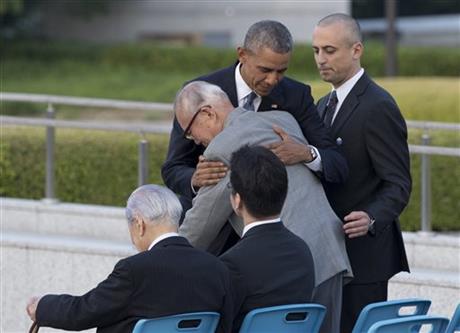
By NANCY BENAC and FOSTER KLUG
With an unflinching look back at a painful history, President Barack Obama stood on the hallowed ground of Hiroshima on Friday and declared it a fitting place to summon people everywhere to embrace the vision of a world without nuclear weapons.
As the first American president to visit the city where the U.S. dropped the first atomic bomb, Obama came to acknowledge — but not apologize for — an act many Americans see as a justified end to a brutal war that Japan started with a sneak attack at Pearl Harbor.
Some 140,000 people died after a U.S. warplane targeted wartime Hiroshima on Aug. 6, 1945, and 70,000 more perished in Nagasaki, where a second bomb was dropped three days later. Japan soon surrendered.
“Their souls speak to us,” Obama said of the dead. “They ask us to look inward, to take stock of who we are and who we might become.”
Sponsored Links
Demo Microsoft Dynamics CRM
Microsoft
The New Chip That’s Disrupting the Tech Industry
Money Morning
With a lofty speech and a warm embrace for an elderly survivor, Obama renewed the call for a nuclear-free future that he had first laid out in a 2009 speech in Prague.
This time, Obama spoke as a far more experienced president than the one who had employed his upbeat “Yes, we can” campaign slogan on the first go-round.
The president, who has made uneven progress on his nuclear agenda over the past seven years, spoke of “the courage to escape the logic of fear” as he held out hope for diligent, incremental steps to reduce nuclear stockpiles.
“We may not realize this goal in my lifetime, but persistent effort can roll back the possibility of catastrophe,” he said.
Obama spent less than two hours in Hiroshima but seemed to accomplish what he came for. It was a choreographed performance meant to close old wounds without inflaming new passions on a subject still fraught after all these years.
In a solemn ceremony on a sunwashed afternoon, Obama and Japanese Prime Minister Shinzo Abe placed wreaths before the cenotaph, a simple arched stone monument at Hiroshima’s Peace Memorial Park. Only the clicking of camera shutters intruded on the moment as Obama closed his eyes and briefly bowed his head.
Then, after each leader gave brief remark, Obama approached two aging survivors of the bombing who were seated in the front row, standing in for the thousands still seared by memories of that day.
Ninety-one-year-old Sunao Tsuboi, the head of a survivors group, energetically engaged the president in conversation, telling Obama he would be remembered as someone who listened to the voice of a few survivors. He urged him to come back and meet more.
“He was holding my hands until the end,” Tsuboi said. “I was almost about to ask him to stop holding my hands, but he wouldn’t.”
Obama stepped over to meet historian Shigeaki Mori. Just 8 when the bomb hit, Mori had to hold back tears at the emotion of the moment.
Obama patted him on the back and wrapped him in a warm embrace. From there, Obama and Abe walked along a tree-lined path toward a river that flows by the iconic A-bomb dome, the skeletal remains of an exhibition hall that stands as silent testimony to the awful power of the bomb blast 71 years ago and as a symbol for international peace.
Abe welcomed the president’s message and offered his own determination “to realize a world free of nuclear weapons, no matter how long or how difficult the road will be.”
Obama received a Nobel Peace Prize early in his presidency for his anti-nuclear agenda but has seen uneven progress. The president can point to last year’s Iran nuclear deal and a weapons treaty with Russia. But North Korea’s nuclear program still looms as a threat, and hopes for a pact for further weapons reductions with Russia have stalled. Critics also fault the administration for planning a big and costly program to upgrade U.S. nuclear stockpiles.
Just as Obama had delicate sensitivities to manage in Hiroshima, so too did Abe. The Japanese leader made a point to dismiss any suggestion that he pay a reciprocal visit to Pearl Harbor.
Abe did not rule out coming to Hawaii someday, but clearly wanted to avoid any notion of moral equivalence. In Japan, Pearl Harbor is not seen as a parallel for the bombings of Hiroshima and Nagasaki, but as an attack on a military installation that did not target civilians.
Bomb survivor Kinuyo Ikegami, 82 paid her own respects at the cenotaph early Friday, before the politicians arrived.
“I could hear schoolchildren screaming: ‘Help me! Help me!'” she said, tears running down her face. “It was too pitiful, too horrible. Even now it fills me with emotion.”
Obama went out of his way, in speaking of the dead, to mention that thousands of Koreans and a dozen American prisoners were among those who died. It was a nod to advocates for both groups who had publicly warned the president not to forget about them in Hiroshima.
In a brief visit to the museum at the peace park, Obama visited a display about a young girl who survived the bombing but died several years later of leukemia. She folded paper cranes in the hospital until she died and is the inspiration for the story of Sadako and the thousand cranes.
___



